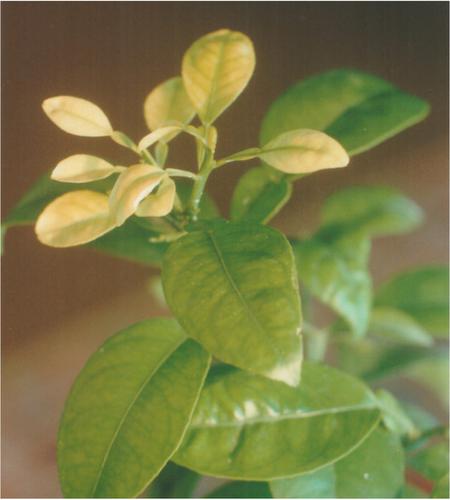当前位置:
X-MOL 学术
›
Plant Pathol.
›
论文详情
Our official English website, www.x-mol.net, welcomes your
feedback! (Note: you will need to create a separate account there.)
Selective transmission of the seedling yellows‐type genotypic variants of Citrus tristeza virus by Aphis gossypii in northern Iran
Plant Pathology ( IF 2.3 ) Pub Date : 2020-05-01 , DOI: 10.1111/ppa.13160 Saeedeh Pourhamedi 1 , Ali Barzegar 1 , Heshmatollah Rahimian 1
Plant Pathology ( IF 2.3 ) Pub Date : 2020-05-01 , DOI: 10.1111/ppa.13160 Saeedeh Pourhamedi 1 , Ali Barzegar 1 , Heshmatollah Rahimian 1
Affiliation

|
Citrus tristeza virus (CTV) has existed in northern Iran for more than five decades. The long‐time interaction of different virus genotypes with Aphis gossypii, as the only aphid vector of CTV in northern Iran, has led to the emergence of highly virulent subpopulations, among others, in the established foci. Here, we studied the population structure of the originally established CTV isolates present in Satsuma mandarin (Citrus unshiu) trees imported from Japan, and subisolates thereof, formed following experimental transmission by A. gossypii, as well as those evolved through natural transmission by this aphid species in the groves. Symptoms of the naturally spread and the experimentally aphid‐transmitted isolates were similar to those of the Satsuma CTV source isolates for all indicator plants except for sour orange (Citrus aurantium) and grapefruit (Citrus paradisi), with the aphid‐transmitted isolates additionally inducing severe seedling yellows and stunting in these two indicators. Studies on the population heterogeneity of these isolates through comparison of their single‐strand conformational polymorphism profiles and nucleotide sequences of the 25 kDa capsid protein gene from the predominant haplotypes, and dot‐blot hybridization signals, revealed the presence of two major T36‐ and SY568‐ (or NUagA‐) like genotypes along with a minor poorly characterized one in the originally infected Satsuma trees; in contrast, only a certain genomic variant having the highest similarity to the isolate SY568 (and NUagA) was predominant both in the naturally infected trees and in those infected experimentally by A. gossypii. It seems that transmission by A. gossypii to sweet orange (Citrus sinensis) has led to the preponderance of the CTV genomic variants inducing severe seedling yellows in northern Iran.
中文翻译:

伊朗北部棉蚜对柑橘病毒幼苗黄色型基因型变体的选择性传播
Citrus tristeza 病毒 (CTV) 在伊朗北部已经存在了 50 多年。作为伊朗北部唯一的 CTV 蚜虫载体,不同病毒基因型与棉蚜的长期相互作用导致在已建立的疫源地出现高毒力亚群等。在这里,我们研究了从日本进口的萨摩柑橘 (Citrus unshiu) 树中存在的最初建立的 CTV 分离株的种群结构,以及其亚分离株,这些分离株是在 A. gossypii 实验传播后形成的,以及通过这种蚜虫自然传播进化的那些树林中的物种。除了酸橙 (Citrus aurantium) 和葡萄柚 (Citrus paradisi) 外,所有指示植物的自然传播和实验蚜虫传播分离株的症状与萨摩 CTV 源分离株的症状相似,蚜虫传播的分离株还引起严重的苗黄和发育不良这两个指标。通过比较它们的单链构象多态性谱和来自主要单倍型的 25 kDa 衣壳蛋白基因的核苷酸序列以及斑点杂交信号,对这些分离物的种群异质性进行了研究,揭示了两种主要的 T36- 和 SY568 的存在‐(或 NUagA‐)像基因型以及最初感染的萨摩树中的一种轻微的特征不佳的基因型;相比之下,只有与分离株 SY568(和 NUagA)具有最高相似性的某个基因组变体在自然感染的树木和被棉絮菌实验感染的树木中占主导地位。A. gossypii 向甜橙(Citrus sinensis)的传播似乎导致 CTV 基因组变异占优势,导致伊朗北部严重的幼苗黄化。
更新日期:2020-05-01
中文翻译:

伊朗北部棉蚜对柑橘病毒幼苗黄色型基因型变体的选择性传播
Citrus tristeza 病毒 (CTV) 在伊朗北部已经存在了 50 多年。作为伊朗北部唯一的 CTV 蚜虫载体,不同病毒基因型与棉蚜的长期相互作用导致在已建立的疫源地出现高毒力亚群等。在这里,我们研究了从日本进口的萨摩柑橘 (Citrus unshiu) 树中存在的最初建立的 CTV 分离株的种群结构,以及其亚分离株,这些分离株是在 A. gossypii 实验传播后形成的,以及通过这种蚜虫自然传播进化的那些树林中的物种。除了酸橙 (Citrus aurantium) 和葡萄柚 (Citrus paradisi) 外,所有指示植物的自然传播和实验蚜虫传播分离株的症状与萨摩 CTV 源分离株的症状相似,蚜虫传播的分离株还引起严重的苗黄和发育不良这两个指标。通过比较它们的单链构象多态性谱和来自主要单倍型的 25 kDa 衣壳蛋白基因的核苷酸序列以及斑点杂交信号,对这些分离物的种群异质性进行了研究,揭示了两种主要的 T36- 和 SY568 的存在‐(或 NUagA‐)像基因型以及最初感染的萨摩树中的一种轻微的特征不佳的基因型;相比之下,只有与分离株 SY568(和 NUagA)具有最高相似性的某个基因组变体在自然感染的树木和被棉絮菌实验感染的树木中占主导地位。A. gossypii 向甜橙(Citrus sinensis)的传播似乎导致 CTV 基因组变异占优势,导致伊朗北部严重的幼苗黄化。











































 京公网安备 11010802027423号
京公网安备 11010802027423号